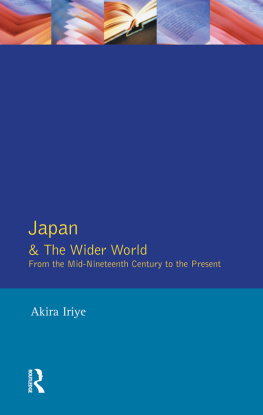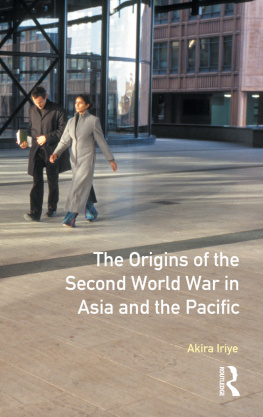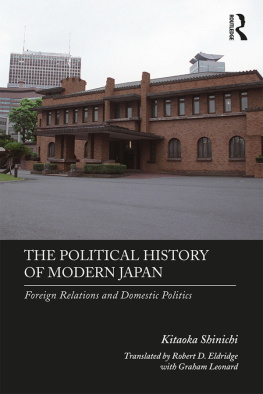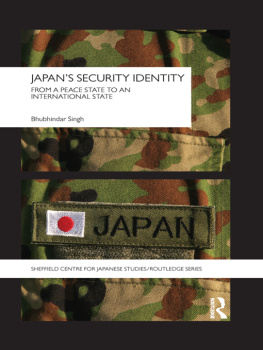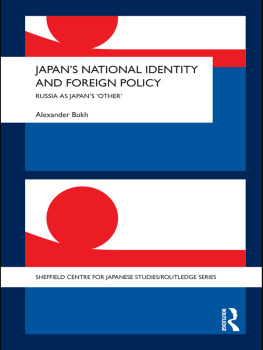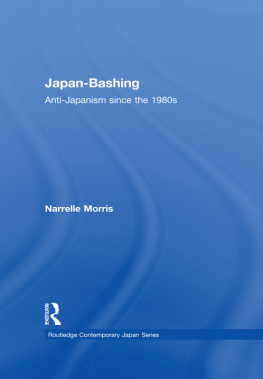JAPAN AND THE WIDER WORLD
.......
JAPAN AND THE WIDER
WORLD
From the Mid-nineteenth Century
to the Present
Akira Iriye
First published 1997 by Pearson Education Limited
Published 2014 by Routledge
2 Park Square, Milton Park, Abingdon, Oxon OX14 4RN
711 Third Avenue, New York, NY 10017, USA
Routledge is an imprint of the Taylor & Francis Group, an informa business
Chuokoron-Sha, Inc. 1997
The right of Akira Iriye to be identified as author of this Work has been asserted by him in accordance with the Copyright, Designs and Patents Act 1988.
All rights reserved. No part of this book may be reprinted or reproduced or utilised in any form or by any electronic, mechanical, or other means, now known or hereafter invented including photocopying and recording, or in any information storage or retrieval system, without permission in writing from the publishers.
Notices
Knowledge and best practice in this field are constantly changing. As new research and experience broaden our understanding, changes in research methods, professional practices, or medical treatment may become necessary.
Practitioners and researchers must always rely on their own experience and knowledge in evaluating and using any information, methods, compounds, or experiments described herein. In using such information or methods they should be mindful of their own safety and the safety of others, including parties for whom they have a professional responsibility.
To the fullest extent of the law, neither the Publisher nor the authors, contributors, or editors, assume any liability for any injury and/or damage to persons or property as a matter of products liability, negligence or otherwise, or from any use or operation of any methods, products, instructions, or ideas contained in the material herein.
ISBN 978-0-582-21053-0(pbk)
British Library Cataloguing-in-Publication Data
A catalogue record for this book is available from the British Library
Library of Congress Cataloging-in-Publication Data
Iriye, Akira.
Japan and the wider world: from the mid-nineteenth century to the present / Akira Iriye.
p. cm.
Includes bibliographical references and index.
ISBN 0-582-21054-2. ISBN 0-582-21053-4 (pbk.)
1. JapanForeign relations1868 I. Tide.
DS881.96.I75 1997
Set by 7R
.....
This book is based on two little volumes I have published in Japan: Nihon no gaik (Japanese diplomacy, 1965) and Shin Nihon no gaik (Japanese diplomacy since the war, 1991). Both volumes aim at examining the intellectual foundations (or lack thereof) of Japanese foreign affairs since the opening of the country in the mid-nineteenth century. Rather than being a chronological survey of diplomatic events, they offer my interpretation of the ways in which Japanese policy-makers and their critics (public opinion) have viewed their countrys position and role in the world. The basic assumption here is that the foreign affairs of any country are built on certain ideas and images about a number of communities: national, regional, global, as well as subnational. How a country defines itself, consisting as it does of numerous groups and localities; how national leaders view regional and global realities; and what meanings they, and various opinion-asserting bodies, give to their countrys place in the history and geography of the world these questions provide a point of departure, as well as of continuity, as we study international relations. In this book the reader will note that particular emphasis is given to such themes as Japanese images of the Western powers, cooperation and/or competition with the West, EastWest relations, and pan-Asianism. This is because these themes were almost always at the basis of policy decisions by Japanese officials, and of assertions by their opponents. Japan and the wider world, then, does not just describe the contents of the book; it provides the key framework, the mental universe, in which the Japanese people and their leaders have sought to understand their place and their role in the international community.
The original volumes have been rather well received in Japan, and many people have suggested that I have them translated into English. Instead of presenting a verbatim translation, however, I have decided to make a few changes and add (or delete) a word or a sentence here and there so that the two separate books will smoothly combine into one. Because more than a quarter century elapsed between the writings of the two books, some of my interpretations and conceptual schemes inevitably changed in the meantime, but my interest in viewing international affairs as phenomena in intellectual as well as diplomatic history remains.
I am grateful to the staff of Addison Wesley Longman, for first proposing the project and for having carefully examined the draft translation, and to my original publisher, Chkron, for granting me permission to undertake an English translation. I am only sorry that it has taken rather long, more than three years since the project was first conceived, to complete the translation.
THE ORIGINS OF MODERN
JAPANESE DIPLOMACY
The history of modern Japanese foreign policy begins with the Meiji Restoration of 1868 which put an end to the reign of the Tokugawa shogunate (since the early seventeenth century) and established a new government under the emperor whose palace was moved to Tokyo, the new capital. By then a number of treaties had been signed with Western powers to regulate trade and other matters, and the new Meiji government started out by acknowledging the validity of these treaties. The powers, on their part, extended diplomatic recognition to Tokyo. But, even though Tokugawa officials had dealt with foreign affairs, the Meiji leaders had to learn much about the conduct of diplomacy, about international affairs in general, and, most fundamentally, about the West, its people and its culture.
A good example of this learning experience may be read in Iwakura Tomomis exhortation to his countrymen in 1869: all human beings have horizontal eyes and vertical noses. Even if their hair is red and eyes blue, they are all human, endowed with their ideas of loyalty, filial piety, and marital affection. We should not despise them as barbarians but treat them as courteously as we would friends. Iwakura, a court noble, was one of the young leaders of the Meiji government who, in 187173, led an embassy to the United States and Europe, the first official mission dispatched by the Meiji state. He, like his colleagues, was acutely aware of the need to appeal to his countrymen to overcome their anti-foreign prejudices, products of their over two hundred years isolation from the rest of the world (except for China and the Netherlands, with which limited trade had been carried on even before the 1850s). Iwakura and other leaders knew that not only Japans existence as an independent nation but also the very survival of the Meiji regime would be jeopardized if anti-foreign fanatics created incidents as they had done during the decades preceding the Restoration and brought about foreign intervention; that, too, had happened earlier in Japan and, as they were well aware, in China.

